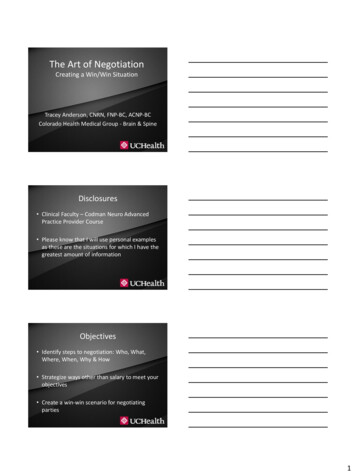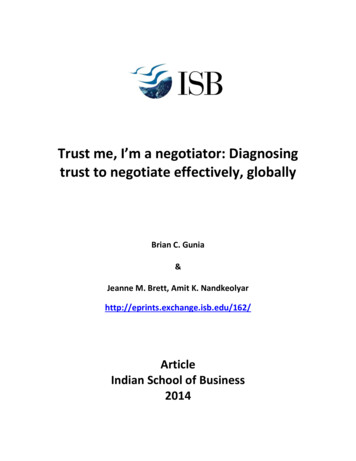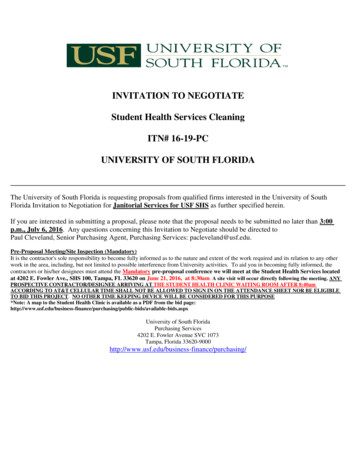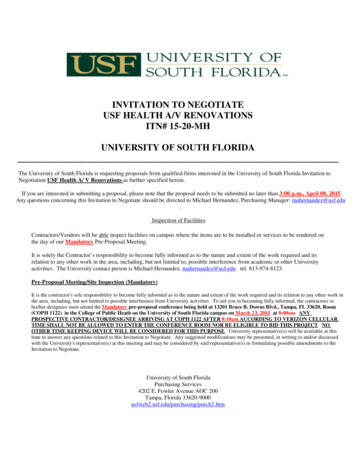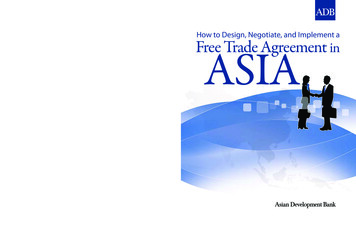
Transcription
About How to Design, Negotiate, and Implement a Free Trade Agreement in AsiaThis reference book, intended to complement the training courses on free trade agreements (FTAs)conducted by ADB, aims to increase the knowledge and capacity of officials who are actively involved indesigning, negotiating, and implementing FTAs. Building on international trade theories and good practicesand FTA experience of countries worldwide, the book explains important facts and benchmarks to beconsidered when preparing, negotiating, and enforcing FTAs in Asia.ADB’s vision is an Asia and Pacific region free of poverty. Its mission is to help its developing membercountries substantially reduce poverty and improve the quality of life of their people. Despite the region’smany successes, it remains home to two thirds of the world’s poor. Nearly 1.7 billion people in the regionlive on 2 or less a day. ADB is committed to reducing poverty through inclusive economic growth,environmentally sustainable growth, and regional integration.Based in Manila, ADB is owned by 67 members, including 48 from the region. Its main instruments forhelping its developing member countries are policy dialogue, loans, equity investments, guarantees, grants,and technical assistance. In 2007, it approved 10.1 billion of loans, 673 million of grant projects, andtechnical assistance amounting to 243 million.Asian Development Bank6 ADB Avenue, Mandaluyong City1550 Metro Manila, Philippineswww.adb.orgPublication Stock No. BBK-119108ISBN: ISBN 978-971-561-684-3Printed in the PhilippinesHow to Design, Negotiate, and Implement a Free Trade Agreement in AsiaAbout Asian Development BankHow to Design, Negotiate, and Implement aFree Trade Agreement inASIA
How to Design, Negotiate, and Implement aFree Trade Agreement in AsiaOffice of Regional Economic IntegrationApril 2008
Asian Development BankAll rights reserved. Published April 2008.Printed in the Philippines.Publication Stock No. BBK119108ISBN 978-971-561-684-3Cataloging-In-Publication DataAsian Development Bank.How to design, negotiate, and implement a free trade agreement in Asia.Mandaluyong City, Phil.: Asian Development Bank, 2008.1. Trade agreement.2. Asia.I. Asian Development Bank.The views expressed in this book do not necessarily reflect the views and policies of theAsian Development Bank (ADB) or its Board of Governors or the governments they represent.ADB does not guarantee the accuracy of the data included in this publication and accepts noresponsibility for any consequence of their use.Use of the term “country” does not imply any judgment by the authors or the AsianDevelopment Bank as to the legal or other status of any territorial entity.ADB encourages printing or copying information exclusively for personal and noncommercialuse with proper acknowledgement of ADB. Users are restricted from reselling, redistributing, orcreating derivative works for commercial purposes without the express, written consent of ADB.Asian Development Bank6 ADB Avenue, Mandaluyong City1550 Metro Manila, PhilippinesTel: 63 2 632 4444Fax: 63 2 636 2444www.adb.orgFor orders, please contact:Department of External RelationsFax: 63 2 636 2648E-mail: adbpub@adb.org
ForewordThe continuing spread of free trade agreements(FTAs) in the developing world—particularlyin Asia—has spurred intense debate. Viewedpragmatically, against the backdrop of slow progress inglobal trade talks, FTAs can promote continued tradeliberalization, induce structural reforms in the economiesconcerned, and widen market access across a vibranteconomic region, where the demand for greater intraregional trade is rapidly increasing.On the negative side, the proliferation of bilateral FTAscan create the so-called “noodle bowl” effect as multiplerules of origin arising from overlapping agreements causeharm particularly to small and medium enterprises withlimited capacity to comply with them. The resultingmarket fragmentation would be more costly even formajor multinational companies because of risingtransaction costs and regulatory barriers. The flow offoreign direct investment and the associated transfer oftechnology and know‑how to smaller economies wouldalso decline.Nevertheless, FTAs are a growing reality. If we recognizethat and hope to foster regional trade agreements asbuilding blocks of global trade and investment integration,we cannot stand idly by and wait for a comprehensiveglobal resolution. We strongly support the Dohanegotiation process, while recognizing the need toconsolidate and streamline regional and bilateral FTAsinto an eventual Greater Asian FTA.The recent proliferation of FTAs in Asia and the Pacificis placing mounting strain on the region’s FTA negotiatingcapacity and on the knowledge and technical skills ofgovernment officials. The areas of interest now go beyondconventional trade in goods and services and extend tointellectual property rights, government procurement, andlabor and environmental issues, among others.
iv How to design, negotiate, and implement a free trade agreement in asiaThe capacity constraints are especiallyacute in poorer countries, which also lackthe institutions to train their officials.This reference book is intended to beused mainly in present and planned FTAtraining courses of the Asian DevelopmentBank, to increase the knowledge andcapacity of officials who are active indesigning, negotiating, and implementingFTAs. Building on theories of internationaltrade economics and the good‑practiceFTA experiences accumulated by bothfront-runners and late beginners in thisarea, the book explains important factsand benchmarks to be considered whenpreparing, negotiating, and enforcing FTAs.Rather than going into the details of specifictopics, this reference book covers the overallFTA process and its main features.With this reference book, we expect tohelp shape common perspectives amonggovernment officials in Asia and thePacific on what a desirable FTA shouldbe, as we look forward to the eventualharmonization of FTAs in this region. Thiscomprehensive version is the first stepin that direction. We hope this referencebook will serve the increasing demand forFTA knowledge in the region.JONG-WHA LEEHeadOffice of Regional Economic Integration
AcknowledgmentsThe Office of Regional Economic Integration (OREI)of the Asian Development Bank (ADB) hasconducted training courses in free trade agreements(FTAs) for mid-level government officials in Asia sinceOctober 2006. Starting with the second program in July2007, we expanded participation to all ADB developingmember countries to meet the growing demand for FTAtraining in the region. Around 100 government officialsfrom all over Asia participated in the training.From the outset, we felt a need for a reference book onFTA for the training course. Drafting a structured textmaterial for the courses was the main objective of thisproject. But this book serves other purposes as well.Government officials who are or will be involved inFTA negotiations can get background knowledge andguidelines on practical issues from this reference book.The general public, including the academe and studentswho are interested in practical aspects of FTA, can alsobenefit from this. It avoids excessively academic ortechnical terms and is written in language that isaccessible to everyone with basic, common-sense ideasabout economics, international trade, and FTAs.Negotiating free trade agreements: a guide, prepared bythe Australian Department of Foreign Affairs and Trade,was the benchmark for this project. Nevertheless, we havetried to cover a wider scope of issues ranging fromfundamental theories to actual components and practicalissues related to FTAs.Jong Woo Kang, Economist, OREI, organized thisproject and coordinated the overall production of thepublication. Michael Plummer of Johns Hopkins Universitywas overall editor of the project.A group of international experts, ADB professionalstaff, and consultants contributed to this reference book.Michael Plummer of Johns Hopkins University andGaneshan Wignaraja, Jong Woo Kang, and RosechinOlfindo (staff consultant) of ADB wrote Part I: Economicsof a Free Trade Agreement.
vi How to design, negotiate, and implement a free trade agreement in asiaSeveral academics and expertscontributed to Part II: Coverage of a FreeTrade Agreement. Rachel MacCullochof Brandeis University wrote on trade ingoods and on environmental and laborstandards; William James of ADB, on rulesof origin; Christopher Findlay of AdelaideUniversity, on trade in services (withsubstantial contribution from Aik LimHoe of the World Trade Organization);Arthur Appleton of Appleton Luff Inc., onintellectual property, dispute settlementmechanisms, sanitary and phytosanitarystandards, and technical barriers to trade;Siow Yue Chia of the Singapore Instituteof International Affairs, on investment andFTA-plus issues, including governmentprocurement and competition policy; andDorothea Lazaro, ADB consultant on tradefacilitation.Finally, Part III: Negotiating,Implementing, and Evaluating Free TradeAgreements was written by Jong WooKang and Dorothea Lazaro of ADB.Special thanks go to those whoresponded to our FTA questionnaire andto the resource persons and participantswho gave valuable comments on Part IIIduring the FTA training courses.JONG WOO KANGProject Manager and EconomistOffice of Regional Economic Integration
ContentsTables, Figures, Case Studies, BoxesAcronyms and AbbreviationsviiixECONOMICS OF A FREE TRADE AGREEMENT1Trade Trends: Regionalization versus RegionalismWhy Enter into a Free Trade Agreement?—Political and Economic GoalsEconomics of COVERAGE OF A FREE TRADE AGREEMENT2Trade in GoodsRules of OriginTrade in ServicesInvestmentFTA-Plus ChaptersDispute Settlement MechanismAppendix31495775839299NEGOTIATING, IMPLEMENTING, AND EVALUATINGFREE TRADE AGREEMENTS3IntroductionPreparing for FTA NegotiationsStructuring the Negotiating TeamThe Negotiation ProcessManaging ConsultationsImplementing an FTAEvaluating an FTAAppendixReferences109114120123125127133135139
Tables, Figures,Case Studies, BoxesTablesTable 1.1 Types of Free Trade Agreements (FTAs)Involving Asia and the Pacific Countries, 2007Table 2.1 Product Origin—Wholly Obtained PrincipleTable 2.2 Tests for Determining Origin of Processed orManufactured Goods45151FiguresFigure 1.1 Number of Free Trade Agreements InvolvingAsia and the Pacific Countries, 1990–2007Figure 1.2 Number of Free Trade Agreements InvolvingAsia and the Pacific Subregions, 2007Figure 2.1 WTO Dispute Settlement FlowchartFigure 3.1 Model FTA ProcessFigure 3.2 Three Levels of FTA CommitteesFigure 3.3 Tariff Elimination Modalitiesfor Negotiating FTAsFigure 3.4 When Consultation Should Be ConductedFigure 3.5 New RTA Transparency MechanismCase StudiesCase 2.1Case 2.2BoxesBox 1.1Box 1.2Box 1.3Box 1.4Box 2.1Box 2.2Republic of Korea–Chile Free Trade AgreementSpecific Commitments for the Movement ofNatural Persons under the Japan-PhilippinesEconomic Partnership AgreementA Brief History of Multilateral Governance underthe World Trade Organization—From the GATTRounds to DohaADB’s Free Trade Agreement DatabaseGATT 1994, Article XXIVComputable General Equilibrium Modelsand Free Trade AgreementsWTO Disciplines in Trade-in-Goods ProvisionsEconomics of Preferential Rules of Origin33931101201241271313373235103250
Tables, Figures, Case Studies, Boxes ixBox 2.3Box 2.4Box 2.5Box 2.6Box 2.7Box 2.8Box 2.9Box 2.10Box 2.11Box 2.12Box 2.13Box 3.1Box 3.2Box 3.3Box 3.4Box 3.5Box 3.6Box 3.7Box 3.8Box 3.9Box 3.10Box 3.11Box 3.12Box 3.13Box 3.14Box 3.15NAFTA Product-Specific Rules of Origin—Textiles and ApparelHow Services Are Traded—The Four“Modes of Supply” in the GATSMeeting the Requirements of GATS Article VA Traditional GATS-Style Positive ListA Simplified Positive ListAn Annex 1 Reservation ListAn Annex 2 Reservation on “Future Measures”Typical Features of Financial ServicesProvisions of FTAsTypical Features of TelecommunicationsServices Provisions of FTAsMovement of Natural Persons—Provisionson Business VisitorsBilateral Investment TreatiesHow the US Negotiates a Trade AgreementUS Trade StrategyJapan’s FTA StrategyUseful Information and Sources for NegotiatorsTypical Composition of Working Groups inthe Negotiating TeamASEAN Approaches to NegotiationNegotiation Approach under the GATSUS Interagency StructureInteragency Coordination Mechanism inthe Republic of KoreaNegotiating Skills and Good Negotiating HabitsExamples of Consultation MechanismsAustralia’s Treaty Approval ProcessLegal Changes Made in SingaporeExamples of FTA WebsitesUS Monitoring and Enforcement 25125126128130132132134
Acronyms RJCTJMEPAJPEPAJSEPAJSGLDCMAIMEAantidumping dutyAsian Development BankASEAN Free Trade AgreementASEAN Investment AreaAsia Pacific Economic CooperationAsia Regional Integration CenterAssociation of Southeast Asian Nationsbilateral investment treatybilateral trade agreementCloser Economic Relations (Australia–New Zealandfree trade agreement)certificate of originchange in tariff headingchange in tariff subheadingDispute Settlement UnderstandingEuropean CommunityEuropean Free Trade AgreementEuropean Unionforeign direct investmentfree on boardfree trade agreementGeneral Agreement on Trade in ServicesGeneral Agreement on Tariffs and TradeGovernment Procurement AgreementGeneralized System of PreferencesHarmonized Systemintellectual propertyintellectual property rightsjoint coordinating teamJapan-Malaysia Economic Partnership AgreementJapan-Philippines Economic Partnership AgreementJapan-Singapore Economic Partnership Agreementjoint study groupleast-developed countrymultilateral agreement on investmentmultilateral environmental agreement
Acronyms and Abbreviations SPSTBTTPRGTPSCTRIMSTRIPSUSTRWCOWIPOWTOmost-favored nationmultinational corporationmutual recognition agreementNorth American Free Trade Agreementnongovernment organizationnontariff barrierOrganisation for Economic Co-operation andDevelopmentPeople’s Republic of Chinarules of originregional trade agreementSingapore-Australia Free Trade AgreementSenior Economic Officials Meetingstate-owned enterprisespecified processsanitary and phytosanitary standardtechnical barriers to tradeTrade Policy Review GroupTrade Policy Staff Committee(Agreement on) Trade-Related Investment Measures(Agreement on) Trade-Related Aspects of IntellectualProperty RightsUnited States Trade RepresentativeWorld Customs OrganizationWorld Intellectual Property OrganizationWorld Trade Organization
Part I:Economics of a FreeTrade AgreementTrade Trends: Regionalizationversus RegionalismRegionalism, which we will define generally here toinclude any formal preferential trading arrangementbetween two or more countries, came late to Asia. Before the turn of the 21st century, there were fewregional trading agreements in existence. While successfulAsian economies by and large exploited the internationalmarketplace effectively, they did so in the context of theGeneral Agreement on Tariffs and Trade (GATT)/WorldTrade Organization (WTO) framework (see Box 1.1 foran overview of the evolution of the multilateral system).However, regionalization, which we will define as amarket-led process of increasing economic interaction, hasbeen building up momentum in Asia for decades, spurredby unilateral liberalization, market-oriented reforms, andsuccessful economic growth in Asia consistently abovethe global average (with the exception of the Asian Crisisyears, 1997–1998). Hence, formal preferential tradingarrangements in the region, particularly in the form offree trade areas (FTAs), are being developed as a meansof enhancing regionalism (“the flag following trade”)rather than the other way around, as was true of suchagreements as colonial preferences or even the earlyyears of European economic integration. In most of Asia,regionalism is being used as part of the overall process ofeconomic reform, to buttress the outward-orienteddevelopment strategies of the region’s economies. Unless specified otherwise, “Asia” throughout the reference book is taken toinclude the Asian Development Bank’s (ADB) 47 regional member countries(see list in ).
How to design, negotiate, and implement a free trade agreement in asiaBox 1.1: A Brief History of Multilateral Governanceunder the World Trade Organization—From the GATT Rounds to DohaThe General Agreement on Tariffs and Trade (GATT)was signed in 1944, with the immediate objective ofpreventing future trade wars and the inconsistentcommercial policies that had plagued internationaltrade in the 1930s. It was originally intended to be atemporary body; the International Trade Organization(ITO) was supposed to replace it as a permanentbody with international legal status, on a par with theother “Bretton Woods Institutions”—the InternationalMonetary Fund and the World Bank. The ITO wasnever ratified; however, the GATT came into effect on 1January 1948 as an ad hoc organization that would takea permanent, legal form only in 1994, with the creationof the World Trade Organization (WTO).The GATT was designed to reduce internationalbarriers to trade on a nondiscriminatory, or “mostfavored nation” (MFN), basis. This would be achievedthrough concerted, multilateral negotiations called“rounds.” Since the creation of the GATT, there havebeen eight rounds, i.e.: Geneva, 1947–1948; Annecy,France, 1949; Torquay, England, 1950–1951; Geneva,1956; the Dillon Round, 1960–1962; the KennedyRound, 1963–1967; the Tokyo Round, 1973–1979; andthe Uruguay Round, 1986–1993. The current WTOnegotiations have been dubbed the Doha DevelopmentAgenda, to underscore the importance of developingcountries in this series of talks. Earlier GATT roundswere successful in reducing tariffs on manufacturedgoods. The Uruguay Round began to address morecomplicated issues, from quantitative restrictions insensitive areas like agriculture and textiles and clothingto trade-related areas such as investment measures andintellectual property protection. The Doha DevelopmentAgenda was initiated to go further down the road of“deep” integration. The process has been difficult, giventhe political sensitivity of many of the key areas beingaddressed. In fact, the 2003 Ministerial Meeting inCancun, Mexico ended without any agreement.The Hong Kong Ministerial Meeting in December 2005was successful in keeping the Doha negotiations alive.The WTO members agreed to undertake liberalizationnegotiations generally under four pillars: NonAgricultural Market Access (NAMA), Agriculture, Services,and Rules (including those pertaining to administrativeactions, e.g., antidumping and countervailing duties,and regional trading agreements). The primacy of the“development dimension” of the talks was reemphasized.The leaders at the meeting set April 2006 as the deadlinefor the Doha package. However, no agreement has yetbeen forthcoming.As we will see throughout this referencebook, regionalism has both positive andnegative elements. After all, FTAs all havediscriminatory features and, therefore,are “second best.” There are in fact noguarantees that a “free trade area” will bea movement in the direction of free trade,its name notwithstanding. It depends verymuch on the agreement. We will argue inthis book that the current FTA movementin Asia is outward-oriented, and that theintentions of economies engaged inthese agreements are pro-market andconsistent with multilateral rules.However, to be certain that regionalismwill support efficient regionalization andcompetitiveness, policy makers mustunderstand the complicated nature ofthese agreements and learn to embracethe positive elements while minimizingthe potentially negative ones. Part I waswritten with this in mind.Rise of Free Trade Agreementsin Asia and the PacificThe rapid spread of regionalism hasbecome one of the most importantrecent developments in the global tradesystem. The proliferation of bilateral andplurilateral FTAs is fundamentally alteringthe world trade landscape. Trade betweenFTA partners now makes up nearly 40%of global trade, and new agreementsincreasingly address issues beyond trade. Asia is a latecomer in the move towardFTAs compared with Europe, the Americas,and Africa, but has seen an unprecedentedincrease in total FTA activity since the1990s. By Asian Development Bank (ADB)estimates, at least one Asian country is Source: Updated from ADB (2006). World Bank (2005). However, the amount of tradethat is actually preferential is smaller because of thecosts of compliance with free trade agreements (FTAs),particularly those associated with the rules-of-originrequirement.Asia in the ADB FTA database refers to Asia and thePacific.
part I: Economics of a free trade agreement involved in 204 FTAs in various stagesof implementation: 95 concluded, 60under official negotiation, and 49 beingproposed (see Box 1.2 for information onADB’s FTA Database, which gives up-todate information and analysis regardingemerging and existing FTAs). This is adramatic increase from the fewer than 10FTAs involving Asian countries in the early1990s (see Figure 1.1).The rise in the number of FTAinitiatives in Asia is driven by a numberof factors including: (i) a defensiveresponse to the proliferation of tradingblocs and FTAs in other major regions;(ii) uncertainty over progress in globaltrade talks under the WTO framework;(iii) the need to improve productivity inthe face of the heightened competitivepressure from the economic emergence ofthe People’s Republic of China (PRC) andIndia, in particular with respect toeconomies of scale through marketintegration; (iv) the perceived need fordeeper integration with trading partners,due in part to the demonstration effectof successful regional integration accordselsewhere; and (v) the promotion of“beyond the border” structural reforms aspart of a competitiveness strategy (e.g.,investment liberalization, promotion ofdomestic competition, harmonization ofstandards, and upgrading of technologydevelopment). The recent increase inFTAs has also been driven by the richestand largest economies in the region suchas the PRC, Japan, Republic of Korea,Singapore, and, Thailand, suggesting alink between FTA growth and economicprosperity, although the exact causationstill needs to be explored further.Box 1.2: ADB’s Free Trade Agreement DatabaseLaunched in October 2006 by ADB and managedby its Office of Regional Economic Integration, the FreeTrade Agreement (FTA) Database in the Asia RegionalInformation Center (ARIC) website (www.aric.adb.org)tracks FTAs of 47 regional members of ADB and providesthree types of information: (i) FTA trends (statistical tableson the status and various categories of FTAs in Asia andthe Pacific); (ii) available resources on each FTA (i.e., legaldocuments, official summary, studies and researches,news, opinions and editorials, FTA membership, and anexternal link to the UNESCAP database); and(iii) a comparative FTA toolkit—an innovative featureof the FTA database—which allows side-by-sidecomparison of around 80 chapters/provisions of morethan 40 concluded FTAs. The list of FTAs on the ARICwebsite is based on official sources (joint statements,declarations, press releases, and government websites).The information about them is also from official sources,research sites, and online news items.Source: ADB.Figure 1.1: Number of Free Trade AgreementsInvolving Asia and the Pacific Countries,1990–2007250Figure 1.2: Number of Free Trade AgreementsInvolving Asia and the PacificSubregions, 2007120100200Proposed80Under urce: ADB FTA Database. Available: www.aric.adb.org2007East AsiaCentral AsiaSouth AsiaSource: ADB FTA Database. Available: www.aric.adb.orgPacific
How to design, negotiate, and implement a free trade agreement in asiaAmong the Asian subregions, East Asia is the most active in forming FTAs: at leastone East Asian economy is involved inany of 112 FTAs, almost twice the numberof FTAs involving Central or South Asiancountries (see Figure 1.2). The Pacific isthe least involved in FTA formation amongthe four Asian subregions. Given the risein the market-based regionalization ofEast Asian economies over the past 20years, that is, the increase in the regionalshares of trade and investment due tomarket-driven activity, the deepening ofregional economic interdependence is themost fundamental rationale behind therecent economic regionalism in EastAsia—an example of the “flag followingtrade.” Since the Asian Crisis of1997–1998, East Asian economies haveembarked on various initiatives under thegeneral rubric of economic regionalismin trade/investment and money/finance.The crisis prompted the subregion’seconomies to realize the importance ofeconomic cooperation and to make effortsto institutionalize such interdependence. An important feature of the rise in thenumber of FTAs in Asia is the growingnumber of overlapping agreements andthe so-called Asian “noodle bowl,” thathas emerged from the proliferation ofbilateral and plurilateral FTAs in theregion. Each FTA can be quite differentin coverage, depth of liberalization, andthe specific regulations that make theaccord function (e.g., rules of origin).According to ADB estimates, Asiancountries are involved in 156 bilateraland 48 plurilateral FTAs in variousstages of implementation. Many of theseagreements—especially the new ones, Unless specified otherwise, “East Asia” in this referencebook refers to the 10 Association of Southeast AsianNations (ASEAN) countries plus the People’s Republicof China (PRC); Hong Kong, China; the Republic ofKorea; Mongolia; Taipei,China; and Japan.See Kawai and Wignaraja (2007).See Kawai (2005).The terms “noodle bowl” and “spaghetti bowl” areused interchangeably throughout this book.are with countries outside the region(see Table 1.1). The fact that many FTAsextend beyond the Asian region itselfunderscores the importance of externalmarkets particularly for the export offinal products. The formation of crossregional agreements is driven by severalfactors including energy security, access tominerals and other natural resources, andefforts by countries to “lock in” reformsby making them part of a formal tradetreaty with a major developed country orregion. Table 1.1: Types of Free Trade Agreements (FTAs)Involving Asia and the PacificCountries, otalFTAsWithin Asia-Pacific732598Outside Asia-Pacific832310615648204Total FTAsSource: ADB FTA Database. Available: www.aric.adb.orgAround half of the established FTAsinvolving at least one Asian country havenot been notified to the WTO. A largeportion of the WTO-notified FTAs involveEast Asian economies, indicating significantadherence in East Asia to WTO rules andprocedures for FTAs. However, many of theprovisions of recent agreements formedby East Asian economies extend beyondthe WTO regulatory framework (“WTOplus agreements”) to include provisionsrelated to a host of “deep” issues such astrade facilitation, investment, governmentprocurement, competition, intellectualproperty, and environment and labor rules.Such provisions are often included in FTAsbetween developed and developingcountries, no doubt reflecting the emphasisthat developed economies give to theseissues. See ADB (2006).
part I: Economics of a free trade agreement Box 1.3: GATT 1994, Article XXIVFree trade agreements (FTAs) represent a departurefrom the General Agreement on Tariffs and Trade(GATT)/ World Trade Organization (WTO) guidingprinciple of nondiscriminatory trade, i.e., mostfvored nation (MFN) treatment, among signatories.Article XXIV of GATT 1994 and the Uruguay Round“Understanding on the Interpretation of Article XXIVof the General Agreement on Tariffs and Trade” providethe rules governing free trade in goods. Article V of theGeneral Agreement on Trade in Services (GATS) givesthe corresponding rules for free trade in services.Article XXIV recognizes the desirability ofincreasing trade through voluntary agreementsbetween two or more members, but it also cautionscountries that such an agreement should be tofacilitate trade among the members and not raisebarriers to trade with non-partner countries. Thisprovision clearly restricts the common externaltariffs imposed by the members of a customs union.However, the preferential margin created by a freetrade area in effect raises barriers to trade with nonpartner countries, resulting in trade diversion, i.e.,the substitution of partner imports for lower-costimports from non-partners. Some economists havesuggested that countries forming free trade areasshould be required to reduce MFN tariff rates tooffset this tendency.As defined in Article XXIV, a free trade area is agroup of two or more countries (“customs territories”)in which duties and other regulations of commerceare eliminated on substantially all the trade betweenthem in products originating in the member countries.Article XXIV distinguishes between a free trade area,where trade barriers have been removed, and anagreement that will eventually lead to the formationof a free trade area. However, key concepts in thisdefinition are left undefined. How much trade is“substantially all trade”? Should the amount of tradecovered be measured in value terms or accordingto the percentage of product categories included?Other than tariffs, which “regulations of commerce,”e.g., trade barriers, must also be eliminated? Exactlywhich goods are considered to have originated in themember countries? Here the agreement must spellout rules of origin for any good produced in the areabut incorporating intermediates imported from nonmembe
Figure 1.1 Number of Free Trade Agreements Involving Asia and the Pacific Countries, 1990-2007 3 Figure 1.2 Number of Free Trade Agreements Involving Asia and the Pacific Subregions, 2007 3 Figure 2.1 WTO Dispute Settlement Flowchart 93 Figure 3.1 Model FTA Process 110 Figure 3.2 Three Levels of FTA Committees 120


